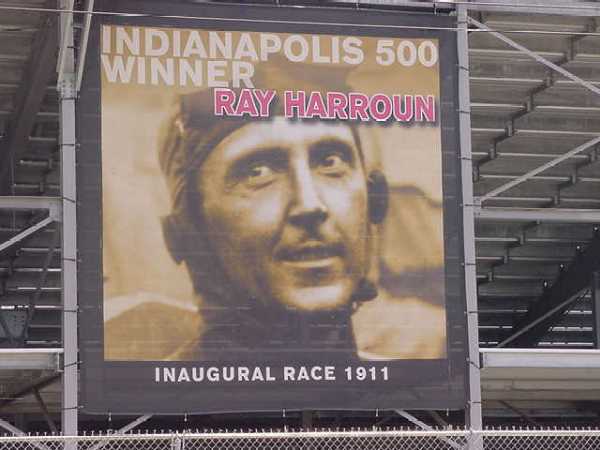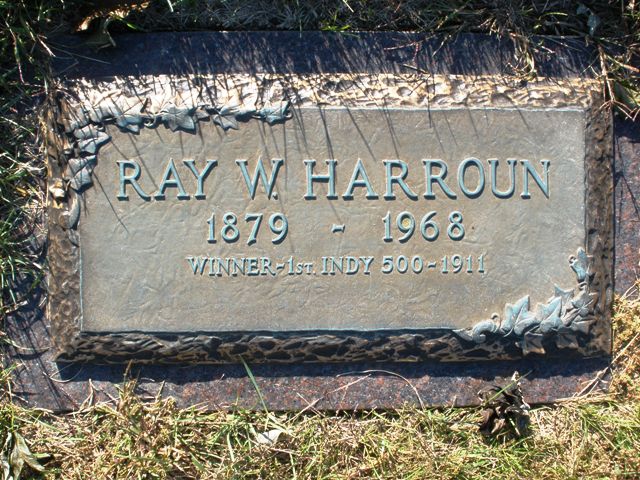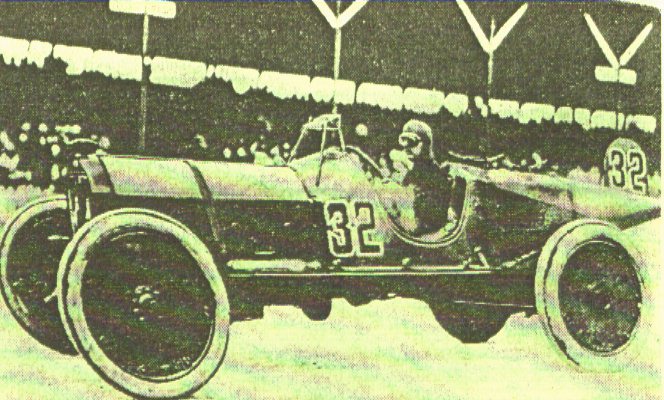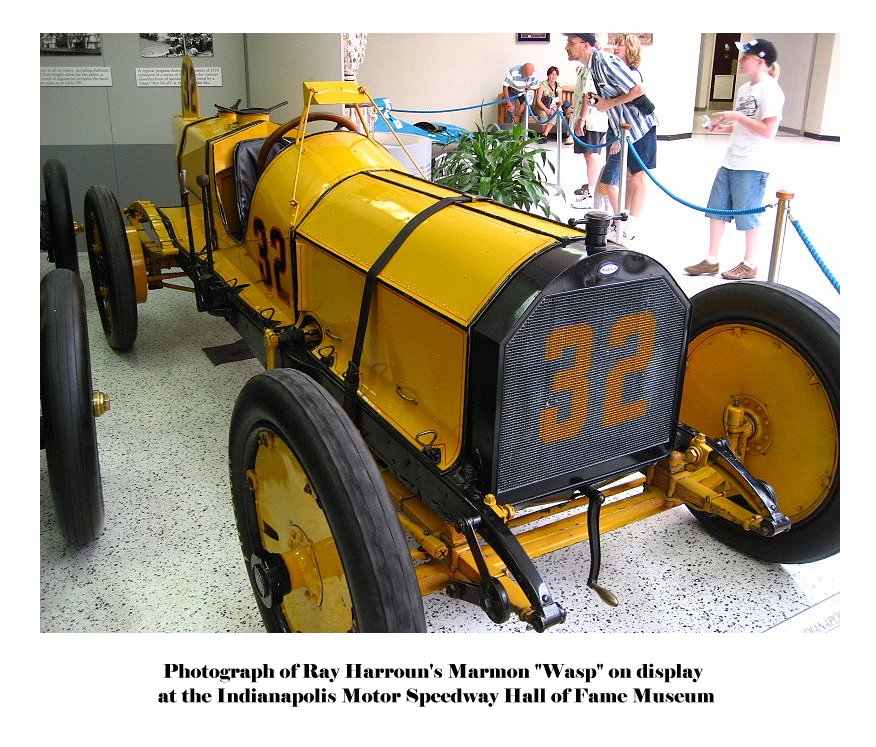| Ray Harroun was born on January
12, 1879 in Spartansburg, Pennsylvania.
He got his elementary education there, but could not concentrate on
classroom work. He built his first car in 1905, and would race anyone
who would challenge him.
In 1910, Harroun accepted an offer from Howard C. Marmon to design and build a racing car to be driven by him in the first big event at the new speedway at Indianapolis. Conventional cars at the time were constructed with two bucket-type seats. Harroun's car had a streamlined body, with only one seat for the driver. Since he would not have a riding mechanic to watch for overtaking vehicles, Harroun constructed a bracket to support a rear view mirror - perhaps, the first. Consequently, the automobile industry started equipping their cars with rear view mirrors. The starting positions were determined by the order of entry. Ray Harroun was on the outside of row seven in the 28th starting position. At 10 am, Tuesday May 30, 1911, the Stoddard-Dayton pace car
pulled off onto the pit apron, Fred Wagner the official starter waved
the green flag, the starting bomb detonated, and the race was on. John
Aitken reached the southwest turn first, followed by Ralph DePalma. By
the fourth lap Spencer Wishart nosed into the lead. By the eighth lap
the leaders held their position, but Ray Harroun moved his yellow
Marmon Wasp up to seventh. He did so not by a reckless charge, but by
knowing his car so well, he could push it to the ragged edge and still
be able to conserve his tires, engine and fuel.
As the race progressed, the lead changed several times, as the leaders see-sawed back and forth. Harroun knew how fast he could go, how fast he had to drive to win, and he kept that pace. There were many drivers that would charge past Harroun, especially Ralph Mulford who was driving a more powerful Lozier. While Mulford would retake the lead by charging past Harroun, he lost time by frequent tire changes. After 6 hours, 42 minutes, 8 seconds and averaging 74.59 miles per hour; Harroun took America's most historic checkered flag. He finished about 5/8 mile ahead of Mulford. The 1911 Indianapolis "500" purse amounted to $27,550, of which Harroun earned $14,000. The Marmon Company let Harroun keep it all, plus a bonus. On the day the award was given, Ray Harroun announced his retirement from driving but not from the automobile business. Harroun was retained as a consulting engineer, for several years. He designed and developed the Harroun carburetor for the 1913 Marmon "48". Harroun designed and built three Maxwell racing cars for the
1914 and 1915 seasons. The success of the Harroun-Maxwell cars was
self-evident by the number of prominent races won by drivers Willie
Carlson, Teddy Tetzlaff and Hall of Famer Eddie Rickenbacker.
During 1916, Harroun rented an office and drafting room space, and proceeded to design an inexpensive, but reliable roadster. In early 1917 Harroun leased a small plant in Wayne, Michigan, formerly used by a buggy and carriage manufacturer. Approximately 500 roadsters were built in this plant during 1917. At the onset of World War I, Harroun entered into a contract with the United States Government for the production of military equipment and munitions. Ray Harroun stayed active the remainder of his life in the production and sales of after-market accessories. Harroun died on January 19, 1968 at Anderson, Indiana. He left a void in the industry that perhaps will never be filled. He pioneered a tradition, which is thriving today, and which no doubt will continue through the 21st century, providing Americans with the greatest sporting "spectacle" in the world. By Michael J. Kollins [Text only] |
|
Inducted into the Michigan Motor Sports Hall of Fame in 2010. Ray was the very first winner of the Indy 500 in 1911 at an average speed of 74.59 MPH, with a race time of 6 hours, 42 minutes, 8 seconds in the legendary Marmon Wasp. The race was sanctioned by the AAA. Even though it was common to have riding mechanics in a race car both preceding and succeeding this period, Ray ran the 1911 race without one. To compensate for that lack of extra eyes in the car, Ray installed a rear-view mirror. It is of common automotive history belief that this was the very first time that a rear view mirror was installed in a car of ANY type, racing or otherwise.  Prior to his historic 1911 Indy 500 win, Ray competed in over 60 races, never finishing out of the top three. Ray was the 1910 AAA National Champion, and won eight major races at the Indy track before the 1911 Indy 500. Ray Harroun won a race on April 13th, 1910 at the one-mile track at Playa del Rey, CA, the nation’s first wooden board track. Ray won that race with a 78 MPH average. He also won a 200 mile race at the Atlanta Motordrome on May 7, 1910. These races also included the 100-lap 1910 Wheeler-Schebler Trophy race, and the 50-lap 1910 Grand Remy Brassard race, both won at the Indianapolis Motor Speedway on the same day, May 29th, 1910. The Indy 500 evolved the next year from these races. Ray also won races at Churchill Downs, Ft. Wayne, Los Angeles, Memphis, and New Orleans in 1910. Ray retired as a driver after his 1911 Indy 500 win, but remained in racing as a car owner with drivers like the famed Eddie Rickenbacker, racing Maxwell cars. During his own driving years, Ray drove mostly Marmons, but also competed with Buicks and cars of his own design, including the Harroun Sneezer and the Harroun Custom. After retiring from racing, Ray lived in Saginaw, Oscoda, and Wayne, Michigan. He founded the Harroun Motor Car Company, which built 500 roadsters in the first year of operation. Ray switched over to wartime production for WWI, making military equipment and munitions. In later years, Ray assisted the WWII effort by designing and building the vehicle that transported and loaded the bombers. He was also assigned the task of designing and building an experimental engine for special military vehicles. It was an 8 cylinder-opposed with one spark plug for 2 cylinders. Ray’s son, Dick Harroun, installed one of those engines into a midget race car owned and driven by racer and friend, Eddie Ostwick, but it was plagued with overheating troubles. He helped his son in his racing career, and Ray raced Go-Karts into his 70’s. Ray Harroun, the very first winner of the Indy 500, passed away in Anderson, IN on January 19, 1968, just days after his 89th birthday. He is survived by his son Richard and family.  |
Return to the Columbia car pages

